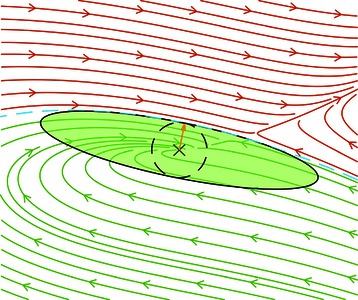Nagy, Péter Tamás (2025) Constructing quadratic Lyapunov functions for conditionally stable fluid dynamics systems. JOURNAL OF FLUID MECHANICS, 1014. No.-A25. (In Press)
|
Text
JFM25_constructing-quadratic-lyapunov-functions-for-conditionally-stable-fluid-dynamics-systems.pdf - Published Version Available under License Creative Commons Attribution. Download (2MB) | Preview |
|
![[img]](https://real.mtak.hu/224326/7.hassmallThumbnailVersion/optimisedImage-png-S0022112025102723_figAb.png)
|
Text (graphical abstract)
optimisedImage-png-S0022112025102723_figAb.png - Published Version Available under License Creative Commons Attribution. Download (929kB) | Preview |
Abstract
This paper explores the construction of quadratic Lyapunov functions for establishing the conditional stability of shear flows described by truncated ordinary differential equations, addressing the limitations of traditional methods like the Reynolds–Orr equation and linear stability analysis. The Reynolds–Orr equation, while effective for predicting unconditional stability thresholds in shear flows due to the non-contribution of nonlinear terms, often underestimates critical Reynolds numbers. Linear stability analysis, conversely, can yield impractically high limits due to subcritical transitions. Quadratic Lyapunov functions offer a promising alternative, capable of proving conditional stability, albeit with challenges in their construction. Typically, sum-of-squares programs are employed for this purpose, but these can result in sizable optimisation problems as system complexity increases. This study introduces a novel approach using linear transformations described by matrices to define quadratic Lyapunov functions, validated through nonlinear optimisation techniques. This method proves particularly advantageous for large systems by leveraging analytical gradients in the optimisation process. Two construction methods are proposed: one based on general optimisation of transformation matrix coefficients, and another focusing solely on the system’s linear aspects for more efficient Lyapunov function construction. These approaches are tested on low-order models of subcritical transition and a two-dimensional Poiseuille flow model with degrees of freedom nearing 1000, demonstrating their effectiveness and efficiency compared with sum-of-squares programs.
| Item Type: | Article |
|---|---|
| Subjects: | T Technology / alkalmazott, műszaki tudományok > TJ Mechanical engineering and machinery / gépészmérnöki tudományok |
| Depositing User: | Dr Péter Tamás Nagy |
| Date Deposited: | 16 Sep 2025 08:48 |
| Last Modified: | 16 Sep 2025 08:48 |
| URI: | https://real.mtak.hu/id/eprint/224326 |
Actions (login required)
 |
Edit Item |




